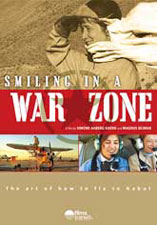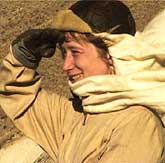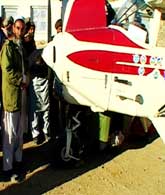Danish artist Simone Aaberg Kærn encountered resistance when she flew her canvas-covered propeller airplane to Kabul in search of the Afghan teenage girl whose dream of being a fighter pilot Kærn had read about in the newspaper. Although women had played an integral role in the physical and intellectual health of Afghanistan, when the Taliban came to power in 1996 women were eliminated from its public sphere entirely. The fall of the Taliban in late 2001 ushered in a new era of reforms aimed at reintegrating Afghanistan’s women into the nation’s schools, political institutions and workplaces; however, as Kærn discovered, Afghan culture remains deeply rooted in conservative religious traditions.
Simone Kærn’s journey to Afghanistan was inspired by an article she read in her morning newspaper, the DAGBLADET POLITIKEN. Below is a translation of the article that set in motion the events of “Flying Down to Kabul.”
A Travel Letter: Behind the Veil in Kabul
By Carsten Jensen
©2002 DAGBLADET POLITIKEN A/S
Rarely do you see a face, or a whole woman. But what you do see is their feet in colorful stockings and thin high-heeled shoes. A tailor predicts that the tent-like burka will disappear from the city streets once spring has arrived. However, the majority of women are careful and stick to the veiled anonymity originally forced upon them by the Taliban.
Kabul is a foot fetishist’s paradise. One won’t spend many hours in Afghanistan’s wrecked and isolated capital before developing an intense interest in feet. Feet are the only part you see of the city’s women. The women know it and, therefore, invest all their vanity in their feet. It is winter and cold, and the dust swirls around in the streets, but the women are still wearing their high-heeled shoes; patent leather seems to be in high fashion this season. Ankle straps are also in, as are patterned stockings. Everything signals that the foot fetishist has found his motherland. Nothing is left for the imagination — except for the rest of the woman, that is.
The visitor begins day two by thinking about whether the burka — a tent-like, pleated garment, behind which women hide — should be subject to the streams of fashion. The burka looks like a uniform. Ninety-five percent of the burkas on the streets are the same color — namely, dove blue, although there is also a moss green variation. These two colors constitute the entire selection. On day three the visitor realizes that he is beginning to feel more at home in Kabul, and that on certain suburban side roads women are walking around with their burkas pushed back so that they flap around them like capes, leaving their faces and bodies entirely exposed. What a miracle! A whole woman! No longer does one need to make do with feet only, but now can get a peek at the whole human being. Nonetheless, there are incredibly few women who aren’t wearing burkas. Nearly three months after Kabul was freed from the medieval and misogynist Taliban regime, the burka is still an integral part of female life.
If you want to know about the political situation and the future of Afghanistan, you are welcome to attend the U.N.’s daily press conferences at the Intercontinental Hotel, where commandants and ministers are interviewed in the hotel lobby. You can also study the cut of the burka, its length and the way it is worn. Tailors know more about the political situation in Afghanistan than political observers do. Women are Afghanistan’s true seismographs, because it is their lives and freedom that are at stake. Right now, fashion trends indictate that the future is uncertain.
The Tailor’s Dream
Mandawi Street is Kabul’s tailor row and is located in the northern part of the Shahzada Market, the money dealers’ market. I enter the largest tailor shop, which has a sale that extends to the street. Entering this shop I expect to meet an avid Taliban supporter who for cautionary reasons has trimmed his beard and taken off his turban. Instead, I find a smiling young man about to stroke the headpiece of a burka. “What does the future of women look like?” I ask. Twenty-two-year old Mohammad Rashid laughs. “Wait for the spring,” he says, “the burka will be gone. There’s a revolution going on in Afghanistan. A new government. Three months ago you weren’t even able to see the women’s feet. Now, the hemlines of the burka steadily go up. And the price goes down. Today, a burka costs half of what it cost just three months ago.”

The filmmakers are planning a theatrical release for the feature-length version of this film under the title, SMILING IN A WAR ZONE. Credit: Cosmo Film Doc |
I ask, “It must bother you that the Taliban is gone — that will affect your business.” “Bother me?” Rashid responds. “I am thrilled that they are gone.” He hits his thigh. “Just look, now I am able to wear jeans again.” Rashid has owned the shop for the past three years together with an uncle. He hired women to sew — all widows of the many mujahedins who were killed in the internal battles of Kabul. The women were not permitted to work due to the Taliban regime but paradoxically they survived by secretly making burkas, the symbol of their very own oppression.
It hasn’t been easy for Rashid to run a store whose clients were solely women. It was forbidden to take the women’s measurements and they were not allowed to come into the store, but had to stay on the street. “Once a woman came into the store and I was sentenced to a week in prison,” Rashid says, and laughs again. Each day he had to recite the Koran and pray. Only after memorizing entire passages from the holy book was he released. “Do you know what they used to call us?” he asks. “They called us ‘the Titanics,’ because we all had the same haircut as the actor Leonardo DiCaprio in the movie TITANIC. It was illegal to watch movies under the Taliban, but we watched TITANIC on video. And then we copied DiCaprio. Of course the Taliban themselves had also seen the movie — how else would they have been able to recognize our hairstyle?” He points at his combed-back hair that is quite accurately parted down the middle, two full locks of hair framing his forehead. He laughs again. “We were 50 ‘Titanics’ sitting in a cell the size of this shop.” He points at the room around him, approximately 16 square meters. “In the neighboring cell, there were 50 truck drivers who were caught listening to a cassette tape. In the next cell over there were people who had owned satellite dishes.”
“What will you do when there’s no longer a demand for burkas?” I ask. “Then I will start making pants,” Rashid laughs. “But above all, I would like to study law at the university.”
Defiant Farial
A skinny and cautious looking 16-year old girl has plans for the future: she wants to be a fighter pilot. I’m meeting her at a private language school, the Tullu English and Science Center. The language school also existed under the Taliban but women had no access, so Farial has been home-schooled for the past two years. Now there are three to four young girls and between 20 and 25 men in each of the language school’s small and crowded classrooms. Farial’s hair is worn in a bun, and she has a beautiful face framed by gold-rimmed glasses. She looks like a fragile little girl even though she is dressed in jeans and a black leather jacket — that is, until you look her in the eyes and realize that her desire to become a fighter pilot is not merely inspired by her English teacher, who happens to be a former pilot. Farial has been arrested three times by the Taliban religious police. Each time, the punishment was the same: she was beaten with sand-filled leather sacks.
The first time it happened, she was only 14 years old. “But I wasn’t afraid — I was infuriated,” she reminisces. Eventually her mother begged her to stop taking off her burka. “But I knew that she was proud of me,” Farial says. Farial lifts her chin and smiles roguishly. “I even fought with a Taliban once. He stopped me on the street and wanted to look through my purse. But it was full of books and I was scared that he was going to confiscate them. So I started hitting him. He got so surprised that he let me go and then I ran off.” We’re both laughing. But the image will not slip from my mind even amidst all the happiness. It is the image of grown-up men beating a 14-year old girl with a baton, simply because she has failed to comply with an idiosyncratic religious prohibition and has showed her face publicly. But there is also another image that stays with me — that of a 14-year old girl limping away in pain, her body covered in bruises. Still, she does not react with fear but is instead full of defiance.
The Fear of the Academic
I spoke with another women in Kabul. It is Yalda Assadi, 18 years of age, with a pretty heart-shaped face and a dark, intense look in her eyes. Only three weeks ago she returned from five years of exile in Pakistan. She is not wearing a burka. “Why in the world should I wear a burka? I am not afraid,” she interrupts. She finds that Kabul has changed since she left five years ago. “The relationship between boys and girls has become strange,” she says. She looks for the right words. “They have become old-fashioned, but that will change,” she says, adding, “God willing.”
F. is a highly educated woman in her mid-40s who doesn’t want her name publicized. She held important positions at the university, both during the Soviet occupation and later on during the short chaotic regime of the mujahedin. She has traveled abroad and authored several textbooks. She has encouraged women to work and become financially independent. Under the Taliban her career ended abruptly. Right in front of her, the religious police burned her transcripts, her ID card, and her private photo album — all evidence of a woman with a career and an active, influential life. Then they beat her husband. She’s also been abused herself, at several locations, and was imprisoned for a short period of time. F. lived in exile in Pakistan, where her family is still living, because the winter in Kabul is harsh and her family’s house is wrecked. She returned to Afghanistan after the fall of the Taliban to work for the U.N. She will not give up. She believes the days of the Taliban in Kabul are numbered, but that they will resurface to power in the provinces. She often hears about new attacks — travelers who have their ears and noses cut off. She admits she is nervous.
F. still wears a burka. So does Jamilla, who started wearing a burka when the Taliban came into power, and who says she will continue to do so in the future. The burka is part of her future; it is part of her and she is never going to take it off. She laughs while saying this. She’s in her late 30s with a healthy, robust face and a straight-forward attitude. It does not bother her that I see her without a burka. The burka is for use on the streets. Now we are in a bakery where she works together with twenty other women. She makes about 90 cents a day, and with that money she tries to support herself and her family. Jamilla is just like the other women in the bakery — a war widow, her husband the victim of the battles between mujahedin fractions. F. is alone with eight kids.
The Will of the World
In the bakery, a skinny woman tosses big hunks of Afghan dough with smooth motions into the burning ashes of the brick oven. Along one of the walls a woman prepares the bread. An old woman kneads the unleavened dough and shapes it into large rolls before she rolls it out. Afterwards, Jamilla makes small indentations in the dough with quick finger movements so that the bread will have its characteristically bumpy surface. A piece of bread costs 200 Afghanis, or about one cent. “Tea, bread, and potatoes,” Jamilla says. That’s what her family lives on. There’s no money for vegetables, rice, or meat.
Before she got a job in the bakery, which is subsidized by a U.N. organization called the World Food Program, she used to do the laundry of strangers, and her sons used to sell chewing gum and cigarettes on the streets. Now they’re in school. The two oldest daughters are illiterate, but when the schools reopen for women, they are going to learn something. Right now, they are at home taking care of the house — a room without water or electricity, where the nine members of the family live together. Under the Taliban Jamilla was always scared. Women were not allowed to work and she was often stopped, interrogated, and harassed on the street on her way to the bakery. Now she believes life will be better. “God is Good,” she says. Jamilla would like for the Americans to stay in Afghanistan. “They will help us,” she says.
“Americans are not Muslims,” I object.
“I don’t care who’s Muslim and who’s not,” she answers back.
“Tell the world to help us. I may not myself directly benefit from the help, but my country needs it.”
My study of the burka, which is both a prison and a pupa, has now come to an end. In the spring, Kabul women will come out, and perhaps, if God and the rest of the world are willing.


